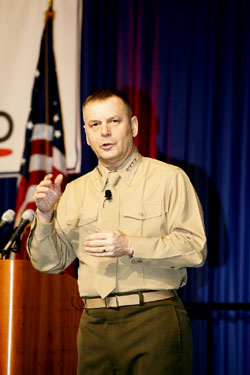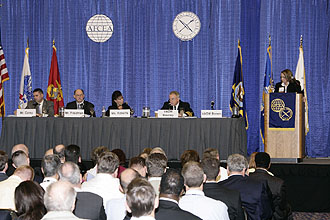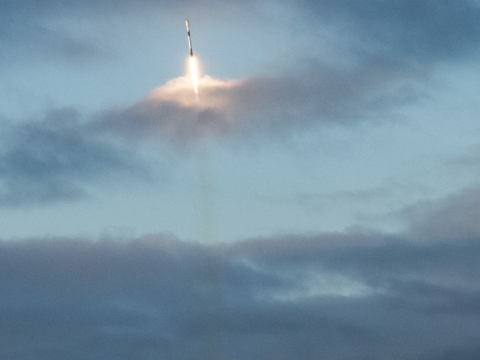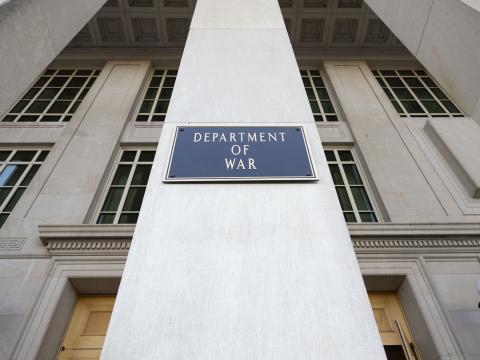West 2010 Online Show Daily:The More Things Change, The More They Really Change
Every type of sociological, economic and military transformation is creating exponentially greater uncertainties.
The information revolution that is sweeping the globe is forcing radical changes in the national security arena. Previous notions of strategic and tactical military planning are being swept away as both time and power have new definitions. And, that information technology realm itself is a major player in the concept of national security.
That was just one message delivered on Day 1 of West 2010, presented by AFCEA International and USNI February 2-4, 2010 in San Diego. Titled “Smart Power: Does the QDR Get It Right?” the program is focusing on the new quadrennial defense review (QDR) and what it portends in this era of terrorism and asymmetrical warfare.
The QDR represents overdue changes in the defense structure, but this year’s version is unusual because it comes in with a new presidential administration but a holdover secretary of defense. Thus, it maintains an unusual degree of continuity, but it does signal a new direction for the military.
|
Gen. James E. Cartwright, USMC, vice chairman of the Joint Chiefs of Staff, describes the changes driving the new Quadrennial Defense Review at West 2010. |
““Whatever it is that we think we’ll do next, whomever it is we think we’ll fight next, we’ll be wrong,” he stated.
A healthy economy is important to national security, he stated. “We’re in a major economic crisis. Economics is a big part of warfare. If you ignore it, you’ll do it at your nation’s peril,” the general declared.
And this economic element also touches upon the change that is sweeping business. “We’re moving from an industrial construct in an industrial age into one that looks more like Moore’s law with a change cycle as long,” Gen. Cartwright said. “How do we build carriers to last 50 years in this cycle? An IED [improvised explosive device] cycle runs about 30 days. The fights that we’re really in—IEDs, cyber, you name it—have a duty cycle of about 30 days.
|
Adm. James G. Stavridis, USN, commander of the U.S. European Command and Supreme Allied Commander Europe, warns of cyberthreats at the West 2010 keynote luncheon. |
The admiral noted that NATO’s Article V provides for the common defense in the event of an attack on any one member. Article VI defines an attack. He said that NATO needs to re-consider the definition of an attack in light of the emergence of cyberspace, which did not exist when NATO was formed.
“I believe that it’s more likely that an attack will come from not a bomb off a bomb rack, but instead electrons in cyberspace,” Adm. Stavridis declared.
|
|
Vice Adm. Nancy Brown, USN (Ret.), former J-6, the Joint Staff (r), leads a discussion about priorities in the cyber domain. The panel comprised (l-r) Robert J. Carey, DON CIO; Dr. Norman Friedman, author; Terry Roberts, executive director at Carnegie Mellon's Software Engineering Institute; and Vice Adm. Carl V. Mauney, USN, deputy commander, STRATCOM. |
Panel member Robert Carey, CIO, USN, pointed out that dangers lurk from all sides of cyberspace. Not only does the U.S. dependence on technology become an Achilles' Heel, but commanders on the front lines now receive so much information that they are drowning in it. As shared with Carey by a commander in Fallujah talking about the endless amount of info that now flows into operations, "I don't want ALL of it; I want IT."
Vice Adm. Carl V. Mauney, USN, deputy commander, STRATCOM, emphasized the importance of the confirming the truth of all the information that's gathered and shared. "Commanders rely on IT for C2 -- to move information, to make decisions -- and we must be able to believe in that information. That is the real problem with the Internet. You can't always count on the validity of the info," he said. "We need to continue to identify and resolve vulnerabilities in our networks. We have not done that very well, and we need to fix that."
Terry Roberts, an executive director with Carnegie Mellon Software Engineering Institute and former deputy director of naval intelligence, said that when it comes to cyber defense, the U.S. Defense Department and other federal agencies have been chasing its tails because everyone looked to STRATCOM as the leader for cyber defense but has not had the authority to do what needed to be done. With the establishment of U.S. Cyber Command, a sub-unified command under STRATCOM, the best of the best personnel from each service has the leadership it needs to be truly effective.
Coming up on Day 2: Adm. David J. “Jack” Dorsett, USN, N2/N6; panels on pirates and North Korea; and a breakfast discussion hosted by David Hartman on the future of the U.S. Navy.







Comments